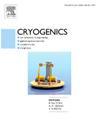Experimental study on catalytic conversion and flow characteristics of ortho-para hydrogen in tubular packed-bed converters at liquid nitrogen temperature
IF 1.8
3区 工程技术
Q3 PHYSICS, APPLIED
引用次数: 0
Abstract
Ortho-para hydrogen conversion is a critical process in hydrogen liquefaction. However, comprehensive data and correlations on the ortho-para hydrogen conversion and pressure drop within catalyst packed beds across the typical range of Reynolds numbers encountered in converters/heat exchangers are still lacking. This study established an experimental setup to measure the catalytic conversion of ortho-para hydrogen and the associated pressure drop in tubular packed-bed converters in the liquid nitrogen temperature range. The effects of the particle size of iron oxide catalysts (20–80 mesh), space velocity (1.5–22 kg/(m3·s)), and packed-bed porosity (0.27–0.46) on the catalytic conversion of ortho-para hydrogen, along with the pressure drop characteristics, were examined at around 77 K and 2 MPa. A correlation was further developed for estimating the outlet concentration of para hydrogen with given space velocity, which would be useful for determining the catalyst dosage based on the targeted conversation rate in the product. Furthermore, by modifying the coefficients for viscous and inertial resistance on the basis of the Ergun equation, pressure drop correlations for packed-bed catalytic converters with different particle sizes were proposed, with remarkably improved predictive accuracy. This work offers critical prediction correlations for the design of ortho-para hydrogen catalytic converters/heat exchangers.
液氮温度下管式填料床催化转化对氢及流动特性的实验研究
正对位氢转化是氢液化的关键过程。然而,在典型的转化器/热交换器雷诺数范围内,关于催化剂填充床内的邻对氢转化和压降的综合数据和相关性仍然缺乏。在液氮温度范围内,建立了管式填料床反应器中邻对氢催化转化及相关压降的实验装置。在77 K和2 MPa条件下,考察了氧化铁催化剂粒径(20 ~ 80目)、空速(1.5 ~ 22 kg/(m3·s))和填充床孔隙率(0.27 ~ 0.46)对邻对氢催化转化的影响及压降特性。在给定空速的情况下,进一步建立了估算对位氢出口浓度的关系式,这将有助于根据产物中的目标转化率确定催化剂用量。在Ergun方程的基础上,通过修正粘性阻力系数和惯性阻力系数,建立了不同粒径填料床催化转化器的压降关系式,显著提高了预测精度。这项工作为设计邻对氢催化转化器/热交换器提供了关键的预测相关性。
本文章由计算机程序翻译,如有差异,请以英文原文为准。
求助全文
约1分钟内获得全文
求助全文
来源期刊

Cryogenics
物理-热力学
CiteScore
3.80
自引率
9.50%
发文量
0
审稿时长
2.1 months
期刊介绍:
Cryogenics is the world''s leading journal focusing on all aspects of cryoengineering and cryogenics. Papers published in Cryogenics cover a wide variety of subjects in low temperature engineering and research. Among the areas covered are:
- Applications of superconductivity: magnets, electronics, devices
- Superconductors and their properties
- Properties of materials: metals, alloys, composites, polymers, insulations
- New applications of cryogenic technology to processes, devices, machinery
- Refrigeration and liquefaction technology
- Thermodynamics
- Fluid properties and fluid mechanics
- Heat transfer
- Thermometry and measurement science
- Cryogenics in medicine
- Cryoelectronics
 求助内容:
求助内容: 应助结果提醒方式:
应助结果提醒方式:


